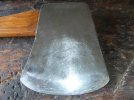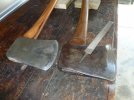Hello,
Last week I discovered a couple of old axes and have began to restore them. This is the first time I have done this, but have not been completely in the dark on account of the info available on the web (including this forum). I am posting this because I have a few questions specific to these axes (I will do them one at a time) and also thought some of you would be interested.
Thanks for reading and responding.
My process for restoring the head was standard (happy to provide more detail if wanted): a vinegar bath overnight (I used pickling vinegar because that's what I had on hand), followed by scrubbing with a wire brush and steel wool and then another bath (for about 6 hours). After that I used sandpapers from coarse to fine (finishing with 1500) in one direction from the poll to the bit to make the head shine (was this a good decision or is it better to leave the surface matte?), and a file to get rid of the mushrooming on the poll.

Above: The axe how I found it.

Above: After the vinegar baths and scrubbing.

Above: The polished axe head with filed poll.
This axe was clearly marked with the stamp "Welland Vale 2" (see below). I guessed that the "2" was for 2lbs.

I did some research on Welland Vale (it is listed on the yesteryeartools website: http://www.yesteryearstools.com/Yesteryears Tools/Wellan Vale Co..html) and found out that, located on the Welland Canal in St. Catherine's ON, it was at one time the largest axe producer in Canada. I was able to locate a catalogue (from 1956) for the company at the library.

Above: From the catalogue; this "joiner's axe" most closely resembled the shape of the one I am restoring, and the text reads that it is also available in a 2lb version. This was the only 2lb axe Welland Vale were making in this or any similar pattern.
In fact, this lighter version of the "joiner's axe" (2 rather than 2 1/2lbs) was listed on another page as the "Branching axe" (below):

Can anyone tell me anything about "branching axes"? Not much comes up on a google search.
When I found the axe it had what I thought was a very short handle (about 17 inches) for the size of the head. The catalogue listed only one handle option available for the 2 pound joiner's or "branching" axe, and that was a 26 inch no. 1 hickory:

Both yesteryeartools and a book I found at the library state that the True Temper name began being used in 1950, and that they only used the Welland Vale stamp for 2 years after that, which would date this axe from 1952 or before; however, the 1956 catalogue still showed "Welland Vale" on the axe illustrations, which makes the dating less certain. May
Questions: I've yet to sharpen this axe because I have read so many different suggestions for sharpening (some of which are contradictory) that I've been hesitant to use what I have: a bastard file and fine grit sand paper. Other than that the edge should be convex I'm not sure exactly what I should be doing. There was a page in the Welland Vale (True Temper) catalogue on sharpening, and they suggested a "fan shaped bevel":

Handling: As has been discussed on the internet it is very difficult to find quality replacement handles. Other than making my own, how would I be able to get a 26" type 1 hickory handle? Any ideas? How important do you folk think it is to keep to the original handle size rather than putting one on that suits the user? The eye hole seems pretty large on this axe head:

Thanks,
Wdmn
Last week I discovered a couple of old axes and have began to restore them. This is the first time I have done this, but have not been completely in the dark on account of the info available on the web (including this forum). I am posting this because I have a few questions specific to these axes (I will do them one at a time) and also thought some of you would be interested.
Thanks for reading and responding.
My process for restoring the head was standard (happy to provide more detail if wanted): a vinegar bath overnight (I used pickling vinegar because that's what I had on hand), followed by scrubbing with a wire brush and steel wool and then another bath (for about 6 hours). After that I used sandpapers from coarse to fine (finishing with 1500) in one direction from the poll to the bit to make the head shine (was this a good decision or is it better to leave the surface matte?), and a file to get rid of the mushrooming on the poll.

Above: The axe how I found it.

Above: After the vinegar baths and scrubbing.

Above: The polished axe head with filed poll.
This axe was clearly marked with the stamp "Welland Vale 2" (see below). I guessed that the "2" was for 2lbs.

I did some research on Welland Vale (it is listed on the yesteryeartools website: http://www.yesteryearstools.com/Yesteryears Tools/Wellan Vale Co..html) and found out that, located on the Welland Canal in St. Catherine's ON, it was at one time the largest axe producer in Canada. I was able to locate a catalogue (from 1956) for the company at the library.

Above: From the catalogue; this "joiner's axe" most closely resembled the shape of the one I am restoring, and the text reads that it is also available in a 2lb version. This was the only 2lb axe Welland Vale were making in this or any similar pattern.
In fact, this lighter version of the "joiner's axe" (2 rather than 2 1/2lbs) was listed on another page as the "Branching axe" (below):

Can anyone tell me anything about "branching axes"? Not much comes up on a google search.
When I found the axe it had what I thought was a very short handle (about 17 inches) for the size of the head. The catalogue listed only one handle option available for the 2 pound joiner's or "branching" axe, and that was a 26 inch no. 1 hickory:

Both yesteryeartools and a book I found at the library state that the True Temper name began being used in 1950, and that they only used the Welland Vale stamp for 2 years after that, which would date this axe from 1952 or before; however, the 1956 catalogue still showed "Welland Vale" on the axe illustrations, which makes the dating less certain. May
Questions: I've yet to sharpen this axe because I have read so many different suggestions for sharpening (some of which are contradictory) that I've been hesitant to use what I have: a bastard file and fine grit sand paper. Other than that the edge should be convex I'm not sure exactly what I should be doing. There was a page in the Welland Vale (True Temper) catalogue on sharpening, and they suggested a "fan shaped bevel":

Handling: As has been discussed on the internet it is very difficult to find quality replacement handles. Other than making my own, how would I be able to get a 26" type 1 hickory handle? Any ideas? How important do you folk think it is to keep to the original handle size rather than putting one on that suits the user? The eye hole seems pretty large on this axe head:

Thanks,
Wdmn









